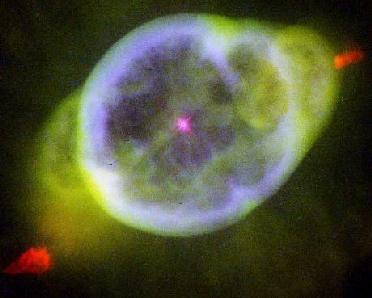In March 2007, Corinne Charbonnel, a French CNRS researcher presently at the Geneva University, and Jean-Paul Zahn, astronomer at the Paris Observatory, had already suggested an explanation to the 3He evolution in the Galaxy. Produced during primordial nucleosynthesis at the beginning of the Universe, this light element is also synthesized by nuclear fusion in the core of low-mass stars like our Sun. Consequently classical models predict a significant increase of the 3He abundance since the Big Bang. But that is not the case, as observations of Galactic H II regions have shown. Corinne Charbonnel explains : "There is not more helium 3 now than at the time of Big Bang. [...] We submit that 3He is indeed produced by stars like our Sun, as the theory predicts, but when the stars evolve and become giants this element is destroyed before being ejected in the interstellar space". In a paper published in Astronomy and Astrophysics (1), Corinne Charbonnel and Jean-Paul Zahn suggested that it is thermohaline mixing that destructs 3He in giant stars, and that stabilizes the 3He abundance in the Galaxy. This mechanism could explain other carbon, nitrogen and lithium anomalies found at the surface of most evolved low-mass stars and that remained unexplained so far. The French-Swiss team demonstrated that from now on, this process should be considered by stellar evolution models.

Jean-Paul Zahn explains that thermohaline mixing is a well-known phenomenon in laboratories and in the oceans. This instability takes the form of salt fingers : it starts when temperature and salinity increase both with height. This same instability appears in evolved stars, when hydrogen combustion is achieved in the core and continues in a thin layer surrounding the stellar core, where 3He acts like salt. Then, all the 3He that the star has produced during its earlier evolution is destroyed.
Corinne Charbonnel and Jean-Paul Zahn now focussed on observations that disagreed with that general scheme : a couple of evolved stars, NGC 3242 and J 320, appear indeed to have eluded the thermohaline mixing because they show a high 3He abundance. In an upcoming paper in Astronomy and Astrophysics, the researchers suggest that a fossil magnetic field suppresses the thermohaline mixing in some rare stars, including NGC 3242 and J 320. They suggest that these specific stars could be descendants of Ap stars. Ap stars were the first objects in which a fossil magnetic field was detected. They account for about 5% of A-type stars. "Our hypothesis will be tested soon with observations at the Pic du Midi or with the Canada-France-Hawaii telescope, " Corinne Charbonnel concludes.
Press release written by Alice Bomboy, with the support of SF2A (Société Française d’Astronomie et d’Astrophysique) See also the A&A Journal Press release | and the one from Geneva Observatory
References
- (1) Thermohaline mixing : a physical mechanism governing the photospheric composition of low-mass giants C.Charbonnel, J.-P. Zahn, 2007, Astronomy & Astrophysics, 467, L15
- (2) Inhibition of thermohaline mixing by a magnetic field in Ap star descendants : Implications for the Galactic evolution of 3He C.Charbonnel, J.-P. Zahn, 2007, Astronomy & Astrophysics, sous presse
Contact
- Jean-Paul Zahn
(Observatoire de Paris, LUTH, et CNRS)
